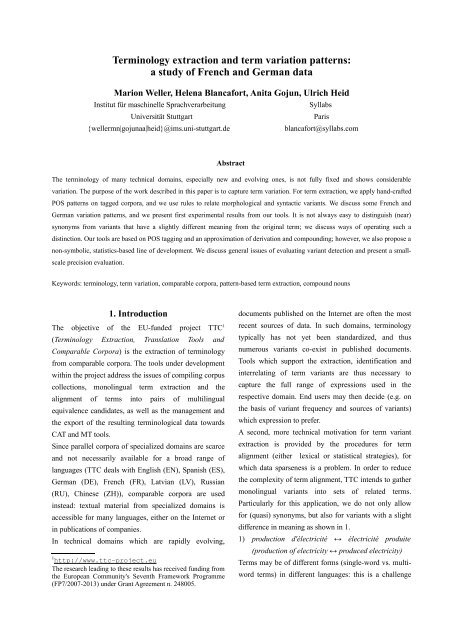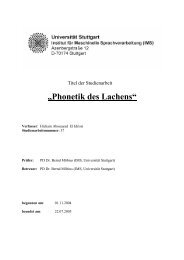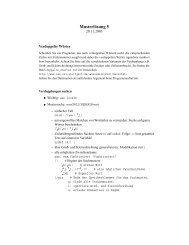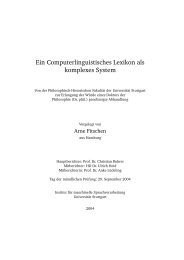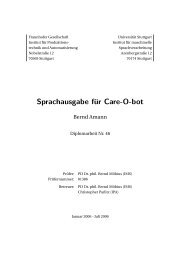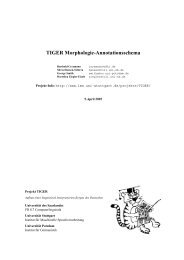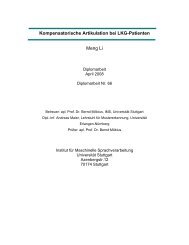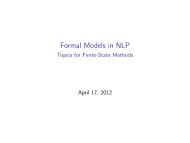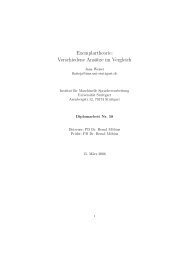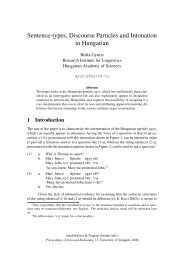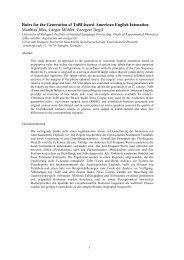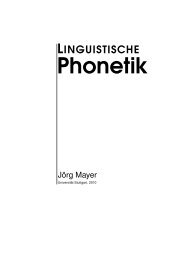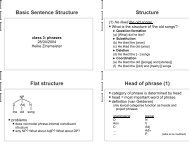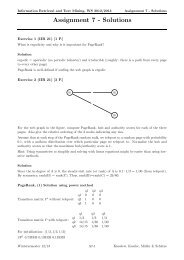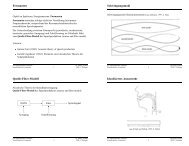URLs - IMS - Universität Stuttgart
URLs - IMS - Universität Stuttgart
URLs - IMS - Universität Stuttgart
Create successful ePaper yourself
Turn your PDF publications into a flip-book with our unique Google optimized e-Paper software.
Terminology extraction and term variation patterns:<br />
a study of French and German data<br />
Marion Weller, Helena Blancafort, Anita Gojun, Ulrich Heid<br />
Institut für maschinelle Sprachverarbeitung Syllabs<br />
<strong>Universität</strong> <strong>Stuttgart</strong> Paris<br />
{wellermn|gojunaa|heid}@ims.uni-stuttgart.de blancafort@syllabs.com<br />
Abstract<br />
The terminology of many technical domains, especially new and evolving ones, is not fully fixed and shows considerable<br />
variation. The purpose of the work described in this paper is to capture term variation. For term extraction, we apply hand-crafted<br />
POS patterns on tagged corpora, and we use rules to relate morphological and syntactic variants. We discuss some French and<br />
German variation patterns, and we present first experimental results from our tools. It is not always easy to distinguish (near)<br />
synonyms from variants that have a slightly different meaning from the original term; we discuss ways of operating such a<br />
distinction. Our tools are based on POS tagging and an approximation of derivation and compounding; however, we also propose a<br />
non-symbolic, statistics-based line of development. We discuss general issues of evaluating variant detection and present a small-<br />
scale precision evaluation.<br />
Keywords: terminology, term variation, comparable corpora, pattern-based term extraction, compound nouns<br />
1. Introduction<br />
The objective of the EU-funded project TTC 1<br />
(Terminology Extraction, Translation Tools and<br />
Comparable Corpora) is the extraction of terminology<br />
from comparable corpora. The tools under development<br />
within the project address the issues of compiling corpus<br />
collections, monolingual term extraction and the<br />
alignment of terms into pairs of multilingual<br />
equivalence candidates, as well as the management and<br />
the export of the resulting terminological data towards<br />
CAT and MT tools.<br />
Since parallel corpora of specialized domains are scarce<br />
and not necessarily available for a broad range of<br />
languages (TTC deals with English (EN), Spanish (ES),<br />
German (DE), French (FR), Latvian (LV), Russian<br />
(RU), Chinese (ZH)), comparable corpora are used<br />
instead: textual material from specialized domains is<br />
accessible for many languages, either on the Internet or<br />
in publications of companies.<br />
In technical domains which are rapidly evolving,<br />
1 http://www.ttc-project.eu<br />
The research leading to these results has received funding from<br />
the European Community's Seventh Framework Programme<br />
(FP7/2007-2013) under Grant Agreement n. 248005.<br />
documents published on the Internet are often the most<br />
recent sources of data. In such domains, terminology<br />
typically has not yet been standardized, and thus<br />
numerous variants co-exist in published documents.<br />
Tools which support the extraction, identification and<br />
interrelating of term variants are thus necessary to<br />
capture the full range of expressions used in the<br />
respective domain. End users may then decide (e.g. on<br />
the basis of variant frequency and sources of variants)<br />
which expression to prefer.<br />
A second, more technical motivation for term variant<br />
extraction is provided by the procedures for term<br />
alignment (either lexical or statistical strategies), for<br />
which data sparseness is a problem. In order to reduce<br />
the complexity of term alignment, TTC intends to gather<br />
monolingual variants into sets of related terms.<br />
Particularly for this application, we do not only allow<br />
for (quasi) synonyms, but also for variants with a slight<br />
difference in meaning as shown in 1.<br />
1) production d'électricité ↔ électricité produite<br />
(production of electricity ↔ produced electricity)<br />
Terms may be of different forms (single-word vs. multi-<br />
word terms) in different languages: this is a challenge
for term alignment. For example, compound nouns play<br />
an important role in German terminology, but have no<br />
equivalents of the same morpho-syntactic structure in<br />
many other languages. Grouping equivalent terms of<br />
different syntactic structures can help to deal with such<br />
cases, as illustrated in 2:<br />
2) Energieproduktion ↔ Produktion von Energie ↔<br />
production d'électricité<br />
(energy production ↔ production of energy)<br />
2. Methodology<br />
The steps required for term extraction and for variant<br />
identification follow a simple pipeline architecture: first,<br />
a corpus collection is compiled, which then undergoes<br />
linguistic pre-processing. Following these steps,<br />
monolingual term candidates are extracted. As not all<br />
extracted items are domain relevant, we apply statistical<br />
filtering. Since we intend to detect term variation on a<br />
morpho-syntactic level, this last step requires<br />
morphological processing in order to model<br />
derivational relationships between word classes.<br />
2.1. Compiling a corpus and pre-processing<br />
To collect corpus data, we use the focused Web crawler<br />
Babouk (de Groc, 2011) which has been developed<br />
within the TTC project. Babouk starts with a set of seed<br />
terms or <strong>URLs</strong> given by the user which are combined<br />
into queries and submitted to a search engine. Babouk<br />
scores the relevance of the retrieved web pages using a<br />
weighted-lexicon-based thematic filter. Based on the<br />
content of relevant retrieved pages, the lexicon is<br />
extended and new search queries are combined.<br />
One objective of the TTC project is to rely on flat<br />
linguistic analysis that is available for all languages.<br />
One strand of research thus goes towards the<br />
development of knowledge-poor strategies, such as<br />
using a pseudo part-of-speech tagger (Clark, 2003) as a<br />
basis for probabilistic NP-extraction (Guégan & Loupy,<br />
2011). A knowledge-rich approach is term extraction<br />
based on hand-crafted part-of-speech (POS) patterns,<br />
which is the method we chose for the present work.<br />
Pre-processing of our data collection consists of<br />
tokenizing, POS-tagging and lemmatization using<br />
TreeTagger (Schmid, 1994). For efficiency reasons, with<br />
German and French being morphologically rich<br />
languages, we work with lemmas rather than inflected<br />
forms.<br />
2.2. Term candidate extraction and filtering<br />
Our main focus is on the extraction of nominal phrases<br />
such as [NN NN] or [NN PRP NN] constructions (cf.<br />
tables 2-5), but [V NN] collocations are also of interest 2 .<br />
For each language, we identify term candidates by using<br />
hand-crafted POS patterns. In contrast to nominal<br />
phrases, which are relatively easy to capture by POS<br />
patterns, the identification of [V NN] collocations is<br />
more challenging, as verbs and their object nouns do not<br />
necessarily occur in adjacent positions, depending on the<br />
general structure of the sentence. This applies<br />
particularly to German where constituent order is rather<br />
flexible and allows for long distances between verbs and<br />
their objects.<br />
In order to reduce the extracted term candidates to a set<br />
of domain-relevant items, we estimate their domain<br />
specificity by comparing them with terms extracted<br />
from general language corpora (Ahmad et al, 1992). The<br />
underlying idea of this procedure is the assumption that<br />
terms which occur in both domain-specific and general<br />
language corpora are not domain-relevant, whereas<br />
terms occurring only or predominantly in the domain-<br />
specific data can be considered as specialized terms. We<br />
use the quotient q of a term's relative frequency in the<br />
specialized data and in the general language corpus as<br />
an indicator for its domain relevance (see table 1).<br />
term candidate f domain f general q<br />
Gleichstrom<br />
(direct current)<br />
128 4 22362,7<br />
Jahr (year) 2157 221.213 1,2<br />
Table 1: Domain-specific vs. general language<br />
2.3. Term variation<br />
In TTC we define a term variant as “an utterance which<br />
is semantically and conceptually related to an original<br />
term” (Daille, 2005). Thus, term variants are bound to<br />
texts (“utterance”) and require the presence of an<br />
“original term” identified e.g. by means of a morpho-<br />
syntactic term pattern.<br />
2 NN:noun, PRP: preposition, V: verb, VPART: participle
The relationship between term variant and original term<br />
is supposed to mainly be one of (quasi-) synonymy or of<br />
controlled modification (e.g. by attributive adjectives,<br />
NPs or PPs). We formalize this by explicitly classifying<br />
relationships between patterns.<br />
We distinguish the following types of variants:<br />
� graphical air flow ↔ airflow<br />
� morphological (derivation, compounding)<br />
Energieproduktion ↔ Produktion von Energie<br />
(production of energy)<br />
solare Energie ↔ Solarenergie (solar energy)<br />
� paradigmatic e.g. omissions<br />
les énergies renouvelables ↔ les renouvelables<br />
(the renewable energies ↔ the renewables)<br />
� abbreviations, acronyms<br />
Windenergieanlage ↔ WEA (wind energy plant)<br />
� syntactic variants 3 consommation d’énergie ↔<br />
consommation annuelle d’énergie<br />
(energy consumption ↔ yearly energy consumption)<br />
Assuming that German technical texts contain many<br />
domain-specific compounds, we focus in this work on<br />
compound nouns and their variant [NN PRP NN] as<br />
illustrated above (morphological variants).<br />
For French, we choose a similar pattern [NN de NN]<br />
↔ [NN VPART]. In our current work, we restrict this<br />
pattern to nouns ending in -tion. The addition of French<br />
morphology tools is planned to widen the scope of these<br />
patterns.<br />
2.4. Morphological processing<br />
In order to identify morphological variants of German<br />
compounds, we need to split compounds into their<br />
components: in the present work, we opt for a statistical<br />
compound splitter; the implementation is based on<br />
(Koehn & Knight, 2003).<br />
Searching for the most probable split of a given word,<br />
the basic idea is that the components of a compound also<br />
appear as single words and consequently should occur in<br />
corpus data. A word frequency list serves as training<br />
data, supplemented with a hand-crafted set of rules to<br />
model transitional elements, such as the s in<br />
Produktions|kosten (production costs).<br />
3 This last type of variants is not necessarily synonymous with<br />
the original term.<br />
For French, we created a set of rules to model the<br />
relationship between nouns ending in -tion and the<br />
respective verbs:<br />
� production → produire (production → produce)<br />
� évolution → évoluer (evolution → evolve)<br />
� condition → conditionner (condition → condition)<br />
� protection → protéger (protection → protect)<br />
Similar rules can be formulated, e.g. for nouns ending in<br />
-ment or -eur, e.g. chargement (nominalized action) →<br />
charger (verb), as well as convertisseur (nominalized<br />
tool name) → convertir (verb). Similarly, terms<br />
containing adjectives ending in -able, such as utilisable<br />
→ utiliser (cf. table 5) or relational adjectives<br />
(prototypique → prototype) are under study. A further<br />
type of pattern that could be added are rules to handle<br />
prefixation (e.g. anti-corrosion → corrosion).<br />
2.5. Processing formally related items<br />
A very common form of graphic variation is<br />
hyphenation, e.g. Luftwärmepumpe vs. Luft-Wärme-<br />
pumpe (air-source heat pump). This type of variation is<br />
dealt with by the splitting programm, which uses<br />
hyphens as splitting points. Hyphenated and non-<br />
hyphenated forms are treated as one term.<br />
To a certain extent, our variant detection tools also deal<br />
with alternating transitional elements (Kraftwerkbetrieb<br />
vs. Kraftwerksbetrieb). This is modeled by hand-crafted<br />
rules which allow for several realizations. Additionally,<br />
there are relatively regular forms of spelling variation,<br />
e.g. the new/old orthography in German, resulting in<br />
e.g. ph/f variation. This can be dealt with either by rules<br />
or using a method based on string-distance.<br />
3. Experiments and examples of results<br />
Our experiments are based on comparable corpora<br />
crawled from the Web. While they are generally easy to<br />
obtain with a focused crawler, such corpora might be<br />
inhomogeneous with respect to domain coverage or<br />
types of sources. When working with several languages,<br />
the degree of comparability may also vary.<br />
We use a collection of 1000 documents each for French<br />
and German, with a total size of 1.55 M tokens (FR) and<br />
1.29 M tokens (DE) of the domain of wind energy.<br />
When looking at the extracted German data, we find that
Abgabe von Wärme 1 Wärmeabgabe 18 release of warmth<br />
Beleuchtung von Straße 1 Straßenbeleuchtung 49 street lighting<br />
Erzeugung von Strom 32 Stromerzeugung 569 power generation<br />
Produktion von Strom 4 Stromproduktion 72 power production<br />
Speicherung von Energie 7 Energiespeicherung 37 energy storage<br />
Verbrauch an Primärenergie 1 Primärenergieverbrauch 114 primary energy consumption<br />
Versorgung mit Fernwärme 2 Fernwärmeversorgung 13 district heating<br />
Nutzung von Biomasse 8 Biomassenutzung 7 biomass utilization<br />
Nutzenergie useful energy 89<br />
nutzbar Energie usable energy 24<br />
genutzt Energie used energy 5<br />
nutzbar Energieform usable energy form 9<br />
genutzt Energieform used energy form 4<br />
nutzbar Energiegehalt usable energy content 3<br />
Nutzenergie-Anteil proportion of useful 1<br />
energy<br />
nutzbar Energiemenge usable amount of<br />
energy<br />
Table 4: Variants of the compound Nutzenergie.<br />
the realization of a term as a compound is often more<br />
frequent than the alternative structures [NN PRP NN]<br />
or [NN ARTgen NNgen], as illustrated in table 2. This<br />
does not only apply to common words like Strom-<br />
erzeugung (power generation), but also to comparative-<br />
ly long and more complex words like Fernwärmever-<br />
sorgung (lit. long-distance heat supply: district heating).<br />
We consider this as evidence that the respective<br />
compound nouns are established as terms in the domain<br />
or even in general language. The degree of preference<br />
varies, up to the point of there not being an alternative<br />
realization, as is the case with Windgeschwindigkeit<br />
(wind speed, freq=149), for which one could imagine a<br />
construction like *Geschwindigkeit des Windes (speed<br />
of the wind), which does not occur in our corpus.<br />
In contrast to the German structures, the French terms<br />
Table 2: Prepositional phrases vs. compound nouns<br />
consommation d'électricité electricity consumption 28 électricité consommée consumed electricity 15<br />
consommation d'énergie energy consumption 66 énergie consommée consumed energy 22<br />
importation de pétrole import of petroleum 9 pétrole importé imported petroleum 1<br />
production d'électricité electricity production 225 électricité produite produced electricity 95<br />
production de chaleur heat production 26 chaleur produite produced heat 21<br />
installation d'éolienne wind turbine installation 5 éolienne installée installed wind turbine 16<br />
installation de puissance installation of power 1 puissance installée installed power 69<br />
utilisation d'énergie use of energy 5 énergie utilisée used energy 19<br />
Table 3: Related French terms: prepositional phrases vs. noun-participle constructions.<br />
1<br />
énergie utilisée used energy 19<br />
énergie utile useful energy 14<br />
énergie utilisable usable energy 14<br />
forme d'énergie utile useful energy form 2<br />
form d'énergie form of useable 2<br />
utilisable<br />
energy<br />
source d'énergie source of usable 1<br />
utilisable<br />
energy<br />
Table 5: Different combinations of the components<br />
energie and utile.<br />
of the pattern pair 4 [NN de NN] ↔ [NN VPART] in<br />
table 3 are not (near) synonyms, but could rather be<br />
considered as related. While some terms seem to prefer<br />
one of the two patterns, the overall tendency for<br />
preference is less clear than for the German examples.<br />
The difference in meaning (i.e. action vs. situation) does<br />
not allow for full interchangeability of related terms, and<br />
the use of the different forms of realization is context<br />
dependent. Some terms from the pairs contained in<br />
table 3 have different meanings, as is the case with<br />
puissance installée vs. installations de puissance élevée<br />
in example (3).<br />
3) Par contre, le coût et la complexité des installations les réservent<br />
le plus souvent à des installations de puissance élevée pour<br />
4 Note that the extracted lemma of the participle is its infinitive;<br />
we show the inflected form for better readability, i.e.<br />
consommée instead of consommer.
énéficier d’économies d’échelle.<br />
However, due to the cost and complexity of the installations, they<br />
are mostly restricted to installations of high power in order to<br />
benefit from the scaling effects.<br />
In other cases, grammatical and/or stylistic constraints<br />
may lead authors to use one variant rather than another.<br />
For example, compounds in enumerations are rather<br />
split in order to facilitate the combination with other<br />
nouns, e.g. Meeresboden vs. Boden von Meeren in<br />
example (4).<br />
4) Methanhydrat bildet sich am Boden von Meeren bzw. tiefen Seen<br />
Methane hydrate develops at the ground of the sea or deep lakes<br />
In table 4, we show examples of variants in a wider<br />
sense: starting with the compound Nutzenergie (useful<br />
energy), we find the synonym nutzbare Energie (usable<br />
energy) and the related form genutzte Energie (used<br />
energy). In the entries in the lower part of the table (grey<br />
background), the component Energie is part of a<br />
compound noun while still preserving the (basic)<br />
meaning of the term Nutzenergie (useful energy).<br />
The French examples in table 5 correspond to the<br />
German ones (table 4), with related terms consisting of<br />
the basic components in the upper part of the table, and<br />
terms expanded by an additional component in the lower<br />
part of the table (gray background). The forms nutzbar<br />
and utilisable (usable) in table 4 and 5 illustrate one of<br />
the above mentioned variation pattern for adjectives.<br />
4. Evaluation and discussion<br />
4.1. Issues in measuring precision and recall<br />
While it is relatively easy to measure the precision of<br />
identified (near) synonyms (such as the compound ↔<br />
[NN PRP NN] pairs), it is comparatively difficult to<br />
determine the precision of related terms like the ones in<br />
tables 4 and 5, as it is often difficult to decide on the<br />
degree of relatedness.<br />
Even more difficult is the evaluation of recall, which<br />
largely depends on the set of term variation patterns, but<br />
also on the patterns used for term candidate extraction.<br />
In order to avoid noise, term candidate extraction is<br />
restricted to productive patterns; this implies that not all<br />
term variants might be extracted and consequently, that<br />
some may not be available for variant grouping. The<br />
same applies to the set of rules used to group variants.<br />
For example, the French pattern [NN PRP NN] is<br />
restricted to the prepositions de and à. While there might<br />
be valid terms containing other prepositions, they are<br />
excluded from being extracted. Similarly, the large<br />
number of potential paraphrases of German compounds<br />
cannot be captured.<br />
The examples in tables 4 and 5 illustrate the wide range<br />
of possible types of variation and thus the difficulty to<br />
capture and relate the different types of variation. In<br />
addition to the problem of pattern coverage, another<br />
factor is the quality of the morphological tools used to<br />
model the relationship between word classes.<br />
4.2. Evaluation of precision<br />
In a small experiment, we measured the precision of the<br />
100 most-frequent German compound nouns and their<br />
proposed variants: 74 of the variants are valid. Most of<br />
the 26 invalid variants are due to bad PP-attachment, as<br />
illustrated by the following example:<br />
5) Stromkunde (energy customer) → *Kunde mit<br />
Strom (customer with energy)<br />
which is part of the verbal phrase Kunden mit Strom<br />
versorgen (supply costumers with energy). This kind of<br />
error can rather be considered a problem of the<br />
extraction step than of the variant detection.<br />
However, in the examined set of 100 items, there was<br />
one term-variant pair whose derivation is technically<br />
correct, but the meaning is not related:<br />
6) Grundwasser (ground water) → Wasser am Grund<br />
eines Sees (water on the ground of a lake)<br />
4.3. Symbolic vs. non-symbolic approach<br />
By relying on a fixed set of rules for extraction, we<br />
clearly favour precision at the cost of recall.<br />
In order to extract terms without a set of patterns, we<br />
present a knowledge-poor approach for term extraction<br />
using a probabilistic NP extractor and string-level term<br />
variation detection. First, we apply a probabilistic NP<br />
extractor trained on a small corpus annotated manually<br />
with NPs (300 to 600 sentences): this tool has been<br />
described in Guégan & Loupy (2011) for the extraction<br />
of NP chunks and uses a pseudo part-of-speech tagger<br />
(Clark, 2003).<br />
A further non-symbolic procedure consists in relating
extracted terms without relying on a predefined set of<br />
variation patterns. We experimented with comparing<br />
NPs on a string level (using Levenshtein disctance ratio)<br />
and grouping terms by similarity. The resulting term<br />
groups also provide a basis for the automatic derivation<br />
of term variation patterns, which can be used as an input<br />
to the symbolic method.<br />
4.4. Relatedness of term candidates<br />
Using a predefined set of term variation patterns<br />
facilitates the decision whether terms are (near)<br />
synonyms or related. As synonyms, we consider for<br />
example the type [compound noun] ↔ [NN PRP NN].<br />
Structures involving relational adjectives ([ADJ NN]<br />
(DE), [NN ADJ] (FR)), can be expressed by<br />
prepositional phrases, e.g. production énergétique ↔<br />
production d'énergie (energy production ↔ production<br />
of energy).<br />
Similarly, patterns can also help to specify the degree of<br />
relatedness: by explicitly formulating term variation<br />
rules we can differentiate between merely related terms<br />
(e.g. consumption vs. annual consumption) and term<br />
variants where we assume quasi synonymy (cf.<br />
compound nouns in table 2).<br />
A difficult task is the identification of (neoclassical)<br />
synonyms: without additional information (e.g. a<br />
dictionary), it is impossible to relate terms like<br />
Sonnenenergie ↔ Solarenergie (solar energy), as the<br />
relation between Sonne and solar is not known to the<br />
system and cannot be derived by morphological means.<br />
While the terms in the example above are synonyms,<br />
there can be some slight difference in meaning between<br />
neoclassical compounds and their native form: the term<br />
hydroélectricité (hydroelectricity) is more precise than<br />
énergie de l'eau (water energy), and not necessarily a<br />
synonym.<br />
5. Conclusion and next steps<br />
We presented a method for terminology extraction and<br />
for the identification of a certain type of term variation.<br />
Preliminary results show that there are preferences for a<br />
certain type of realization, especially when considering<br />
German compound nouns.<br />
Since our current work only deals with a small part of<br />
variation possibilities, we intend to enlarge our<br />
inventory by exploring more variation patterns. We<br />
particularly plan to include high-quality morphological<br />
tools, e.g. SMOR (Schmid et al., 2004) for German, and<br />
DériF (Namer, 2009) for French. SMOR has proven to<br />
outperform our statistical splitter.<br />
Another strand of research is the exploration of term<br />
variation across languages, e.g. relations between term<br />
variants that are similar within different language pairs.<br />
References<br />
Ahmad, K., Davies, A. , Fulford, H. , Rogers, M. (1992):<br />
What is a Term? The semi-automatic extraction of<br />
terms from text. In Translation Studies - an<br />
Interdiscipline. John Benjamins Publishing Company.<br />
Clark, A. (2003): Combining distributional and<br />
morphological information for part of speech<br />
induction. In Proceedings of the 10th conference of<br />
the European chapter of the Association for<br />
Computational Linguistics. Budapest, Hungary.<br />
Daille, B. (2005): Variants and application-oriented<br />
terminology engineering. In Terminology, volume. 1.<br />
Guégan, M. , de Loupy, C. (2011): Knowledge-Poor<br />
Approach to Shallow Parsing: Contribution of<br />
Unsupervised Part-of-Speech Induction. RANLP 2011<br />
- Recent Advances in Natural Language Processing.<br />
de Groc, C. (2011): Babouk: Focused web crawling for<br />
corpus compilation and automatic terminology<br />
extraction. In Proceedings of the IEEE/WIC/ACM<br />
International Conferences on Web Intelligence and<br />
Intelligent Agent Technology. Lyon, France.<br />
Koehn, P. , Knight, K. (2003): Empirical Methods for<br />
Compound Splitting. In Proceedings of the 10th<br />
conference of the European chapter of the Association<br />
for Computational Linguistics. Budapest, Hungary.<br />
Namer, F. (2009): Morphologie, Lexique et Traitement<br />
Automatique des Langues - Le système DériF.<br />
Hermès – Lavoisier Publishers.<br />
Schmid, H. (1994): Probabilistic part-of-speech tagging<br />
using decision trees. In Proceedings of the<br />
international conference on new methods in language<br />
processing. Manchester, UK.<br />
Schmid, H. , Fitschen, A. , Heid,U. (2004): SMOR: A<br />
German computational morphology covering<br />
derivation, composition and inflection. In Proceedings<br />
of LREC '04. Lisbon, Portugal.


